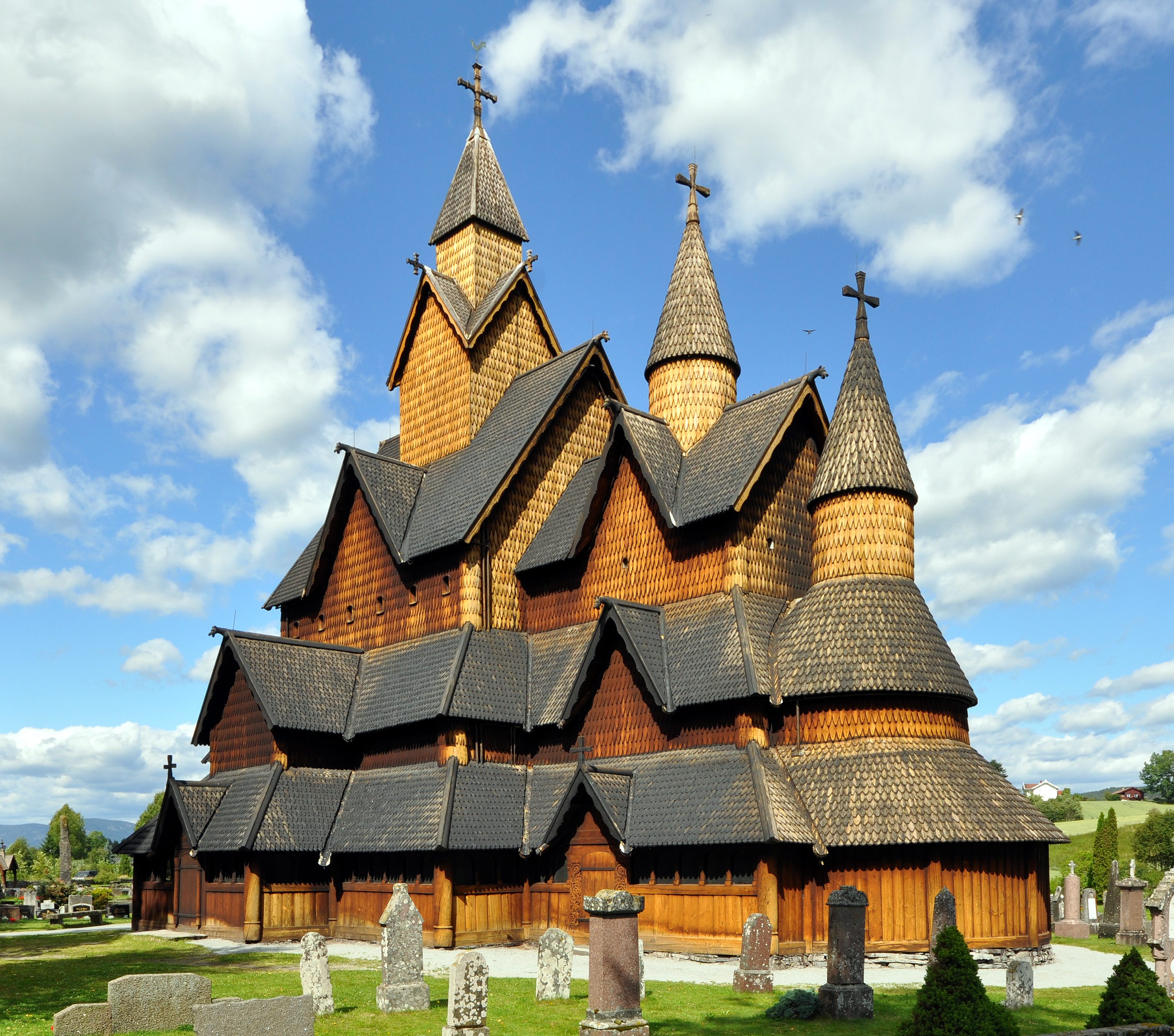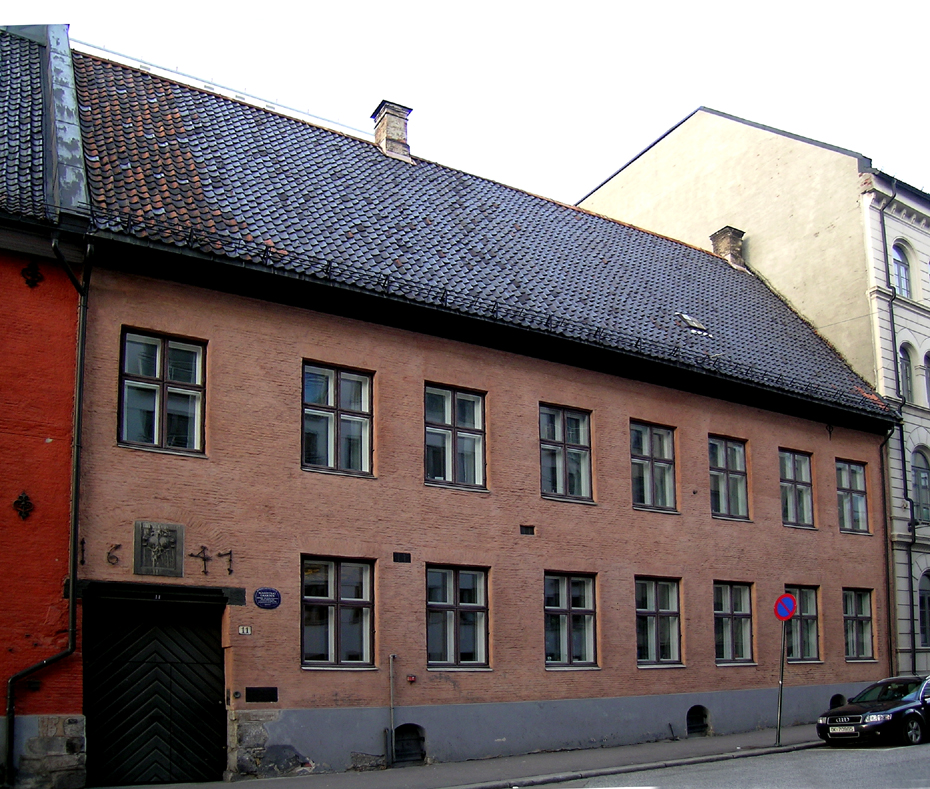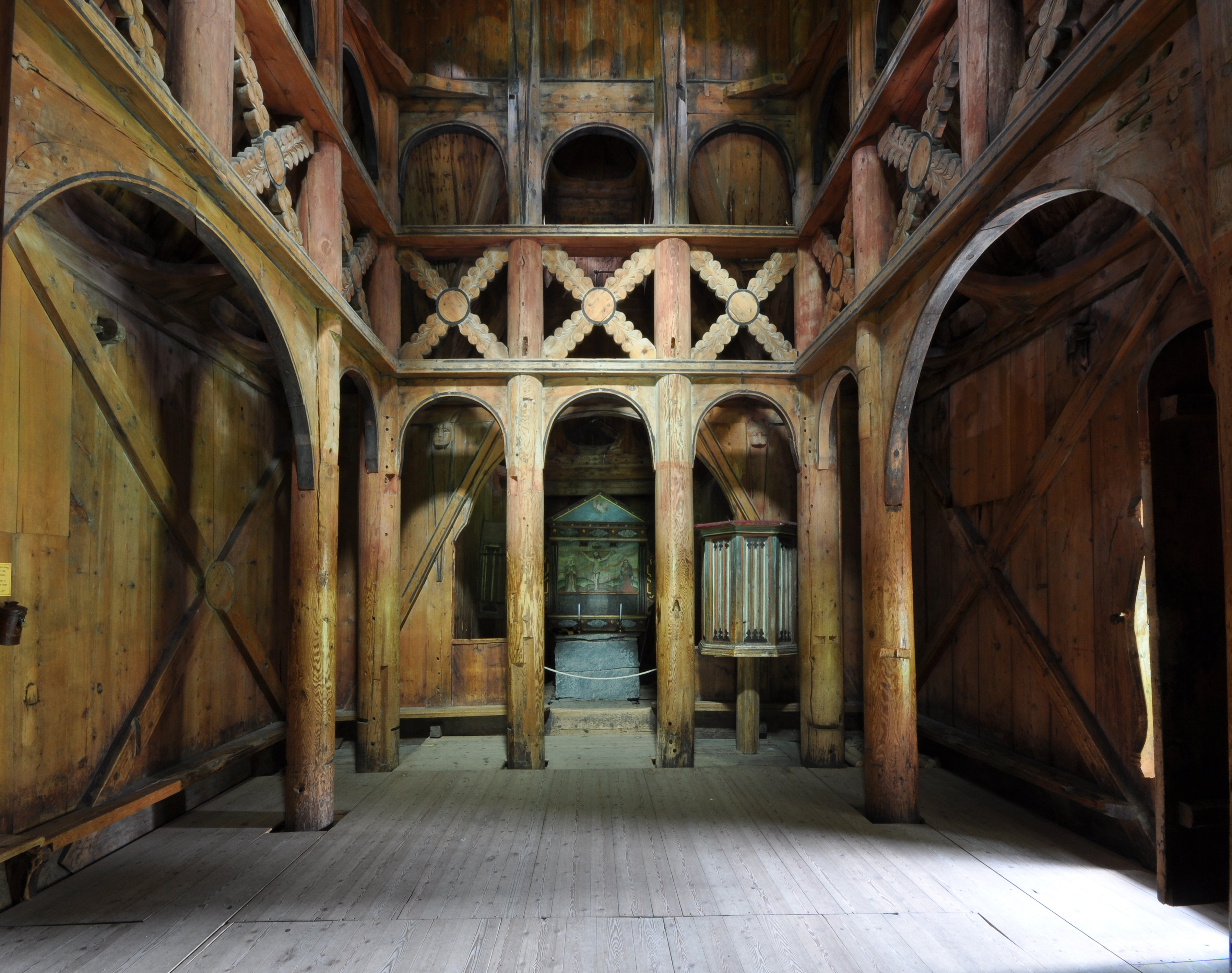|
Borgund Church (Lærdal)
Borgund Church () is a parish church of the Church of Norway in Lærdal Municipality in Vestland county, Norway. It is located in the village of Borgund. It is the church for the Borgund parish which is part of the Sogn prosti (deanery) in the Diocese of Bjørgvin. The red, wooden church was built in a long church design and in the dragestil style in 1868 using plans drawn up by the architect Christian Christie. The church seats about 175 people. History The church was built in 1868 to replace the ancient Borgund Stave Church, located right next to it. The new church was consecrated on 28 August 1868 by Pastor Henning Frimann Dahl. The church was built because the old stave church was too small for the parish, so the new church was built and the old one was turned into a museum. Christian Christie designed a new stave church-inspired building and the lead builders were F. Gade and C. Aghte. In a deal worked out by the local priest and the municipal council, the Society for t ... [...More Info...] [...Related Items...] OR: [Wikipedia] [Google] [Baidu] |
Lærdal Municipality
Lærdal is a municipality in Vestland county, Norway. It is located on the south side of the Sognefjorden in the traditional district of Sogn. The administrative center of the municipality is the village of Lærdalsøyri. The old Filefjell Kongevegen road passes through Lærdal on its way to Valdres and later to Oslo. The municipality is the 71st largest by area out of the 356 municipalities in Norway (with over half of this area consisting of mountains). Lærdal is the 273rd most populous municipality in Norway with a population of 2,129. The municipality's population density is and its population has decreased by 2.2% over the previous 10-year period. The Lærdal river valley is long, running from Hemsedal ( Høgeloft mountain) and the Filefjell mountains in the east to the Sognefjorden in the west. About half of the municipal residents live in the main village of Lærdalsøyri; the rest in the small villages in the surrounding valleys such as Borgund, Ljøsne, Tønjum, ... [...More Info...] [...Related Items...] OR: [Wikipedia] [Google] [Baidu] |
Dragestil
Dragestil () is a style of design and architecture that originated in Norway and was widely used principally between 1880 and 1910. It is a variant of the more embracing National Romantic style and an expression of Romantic nationalism. History The foremost sources of inspiration for the Dragestil style were the Viking and medieval art and architecture of Scandinavia. It had roots in the preservation of stave churches and the recent excavation of historic relics such as the Tune, Gokstad and Oseberg ships. It often featured Norse motifs, such as serpents and dragons, hence its popular appellation. Important proponents in the modern era included Norwegian architects Holm Hansen Munthe and Balthazar Lange. In Germany, the in Potsdam and the Rominten Hunting Lodge were erected for Kaiser Wilhelm II. Characteristic features * Exposed timber walls, often tarred on the exterior with varnished interiors * Decoration in the form of dragon heads * Often steep roofs and big eave ... [...More Info...] [...Related Items...] OR: [Wikipedia] [Google] [Baidu] |
19th-century Church Of Norway Church Buildings
The 19th century began on 1 January 1801 (represented by the Roman numerals MDCCCI), and ended on 31 December 1900 (MCM). It was the 9th century of the 2nd millennium. It was characterized by vast social upheaval. Slavery was Abolitionism, abolished in much of Europe and the Americas. The First Industrial Revolution, though it began in the late 18th century, expanded beyond its British homeland for the first time during the 19th century, particularly remaking the economies and societies of the Low Countries, France, the Rhineland, Northern Italy, and the Northeastern United States. A few decades later, the Second Industrial Revolution led to ever more massive urbanization and much higher levels of productivity, profit, and prosperity, a pattern that continued into the 20th century. The Catholic Church, in response to the growing influence and power of modernism, secularism and materialism, formed the First Vatican Council in the late 19th century to deal with such problems an ... [...More Info...] [...Related Items...] OR: [Wikipedia] [Google] [Baidu] |
Wooden Churches In Norway
Wood is a structural tissue/material found as xylem in the stems and roots of trees and other woody plants. It is an organic materiala natural composite of cellulosic fibers that are strong in tension and embedded in a matrix of lignin that resists compression. Wood is sometimes defined as only the secondary xylem in the stems of trees, or more broadly to include the same type of tissue elsewhere, such as in the roots of trees or shrubs. In a living tree, it performs a mechanical-support function, enabling woody plants to grow large or to stand up by themselves. It also conveys water and nutrients among the leaves, other growing tissues, and the roots. Wood may also refer to other plant materials with comparable properties, and to material engineered from wood, woodchips, or fibers. Wood has been used for thousands of years for fuel, as a construction material, for making tools and weapons, furniture and paper. More recently it emerged as a feedstock for the production of p ... [...More Info...] [...Related Items...] OR: [Wikipedia] [Google] [Baidu] |
Long Churches In Norway
Long may refer to: Measurement * Long, characteristic of something of great duration * Long, characteristic of something of great length * Longitude (abbreviation: long.), a geographic coordinate * Longa (music), note value in early music mensural notation Places Asia * Long District, Laos * Long District, Phrae, Thailand * Longjiang (other) or River Long (lit. "dragon river"), one of several rivers in China * Yangtze River or Changjiang (lit. "Long River"), China Elsewhere * Long, Somme, France People * Long (Chinese surname) * Long (Western surname) Fictional characters * Long (''Bloody Roar''), in the video game series * Long, Aeon of Permanence in Honkai: Star Rail Sports * Long, a fielding term in cricket * Long, in tennis and similar games, beyond the service line during a serve and beyond the baseline during play Other uses * , a U.S. Navy ship name * Long (finance), a position in finance, especially stock markets * Lòng, name for a laneway in Sh ... [...More Info...] [...Related Items...] OR: [Wikipedia] [Google] [Baidu] |
Churches In Vestland
Church may refer to: Religion * Church (building), a place/building for Christian religious activities and praying * Church (congregation), a local congregation of a Christian denomination * Church service, a formalized period of Christian communal worship * Christian denomination, a Christian organization with distinct doctrine and practice * Christian Church, either the collective body of all Christian believers, or early Christianity Places United Kingdom * Church, a former electoral ward of Kensington and Chelsea London Borough Council that existed from 1964 to 2002 * Church (Liverpool ward), a Liverpool City Council ward * Church (Reading ward), a Reading Borough Council ward * Church (Sefton ward), a Metropolitan Borough of Sefton ward * Church, Lancashire, England United States * Church, Iowa, an unincorporated community * Church Lake, a lake in Minnesota * Church, Michigan, ghost town Arts, entertainment, and media * '' Church magazine'', a pastoral theology magazi ... [...More Info...] [...Related Items...] OR: [Wikipedia] [Google] [Baidu] |
Lærdal
Lærdal is a municipality in Vestland county, Norway. It is located on the south side of the Sognefjorden in the traditional district of Sogn. The administrative center of the municipality is the village of Lærdalsøyri. The old Filefjell Kongevegen road passes through Lærdal on its way to Valdres and later to Oslo. The municipality is the 71st largest by area out of the 356 municipalities in Norway (with over half of this area consisting of mountains). Lærdal is the 273rd most populous municipality in Norway with a population of 2,129. The municipality's population density is and its population has decreased by 2.2% over the previous 10-year period. The Lærdal river valley is long, running from Hemsedal ( Høgeloft mountain) and the Filefjell mountains in the east to the Sognefjorden in the west. About half of the municipal residents live in the main village of Lærdalsøyri; the rest in the small villages in the surrounding valleys such as Borgund, Ljøsne, Tønju ... [...More Info...] [...Related Items...] OR: [Wikipedia] [Google] [Baidu] |
List Of Churches In Bjørgvin
The list of churches in Bjørgvin is a list of the Church of Norway churches in the Diocese of Bjørgvin in Norway. It includes all of the parishes in Vestland county. The Diocese is based at the Bergen Cathedral in the city of Bergen (city), Bergen in Bergen Municipality. The list is divided into several sections, one for each deanery (; headed by a Provost (religion), provost) in the diocese. Administratively within each deanery, the churches within each municipality elects their own church council (). Each municipality may have one or more parishes () within the municipality. Each parish elects their own councils (). Each parish has one or more Parish church, local church. The number and size of the deaneries and parishes has changed over time. The Laksevåg prosti (created in 1990) in Bergen was dissolved in 2013 and its churches were divided between the Bergen domprosti and the Fana prosti. Also in 2013, the old Ytre Sogn prosti was dissolved. The old deanery included Gulen ... [...More Info...] [...Related Items...] OR: [Wikipedia] [Google] [Baidu] |
Stave Church
A stave church is a medieval wooden Christian church building once common in north-western Europe. The name derives from the building's structure of post and lintel construction, a type of timber framing where the load-bearing ore-pine posts are called ''stafr'' in Old Norse (''stav'' in modern Norwegian). Two related church building types also named for their structural elements, the post church and palisade church, are often called 'stave churches'. Originally much more widespread, most of the surviving stave churches are in Norway. The only remaining medieval stave churches outside Norway are: Hedared stave church () in Sweden and the Vang Stave Church which was built in Norway and relocated in 1842 to contemporary Karpacz in the Karkonosze mountains of Poland. One other church, the Anglo-Saxon Greensted Church in England, exhibits many similarities with a stave church but is generally considered a palisade church. Construction Archaeological excavations have ... [...More Info...] [...Related Items...] OR: [Wikipedia] [Google] [Baidu] |
Society For The Preservation Of Ancient Norwegian Monuments
Society for the Preservation of Ancient Norwegian Monuments () is an organization focused on conservation preservation in Norway. The Society was founded in 1844. The founders were painters, historians, art historians and archeologists, including J. C. Dahl and Joachim Frich. Nicolay Nicolaysen became chairman in 1851 and from 1860 was the association antiquarian. The purpose of the association is to protect and preserve buildings, churches and other forms of cultural heritage. It owns forty structures directly, including the stave churches at Borgund stave church, Borgund, Urnes stave church, Urnes, Hopperstad stave church, Hopperstad and Uvdal stave church, Uvdal. The Society has 18 county branches and 37 local branches in the counties. The branch structure resembles the counties of Norway, county structure of Norway, except that Oslo and Akershus are together, Møre and Romsdal is split into Sunnmøre, Nordmøre and Romsdal, and the town of Røros (town), Røros is a division of ... [...More Info...] [...Related Items...] OR: [Wikipedia] [Google] [Baidu] |
Consecrate
Sacred describes something that is dedicated or set apart for the service or worship of a deity; is considered worthy of spiritual respect or devotion; or inspires awe or reverence among believers. The property is often ascribed to objects (a " sacred artifact" that is venerated and blessed), or places (" sacred ground"). French sociologist Émile Durkheim considered the dichotomy between the sacred and the profane to be the central characteristic of religion: "religion is a unified system of beliefs and practices relative to ''sacred things'', that is to say, things set apart and forbidden." Durkheim, Émile. 1915. '' The Elementary Forms of the Religious Life''. London: George Allen & Unwin. . In Durkheim's theory, the sacred represents the interests of the group, especially unity, which are embodied in sacred group symbols, or using team work to help get out of trouble. The profane, on the other hand, involve mundane individual concerns. Etymology The word ''sacred' ... [...More Info...] [...Related Items...] OR: [Wikipedia] [Google] [Baidu] |
Borgund Stave Church
Borgund Stave Church () is a former parish church initially of the Catholic Church and later the Church of Norway in Lærdal Municipality in Vestland county, Norway. It was built around the year 1200 as the village church of Borgund, and belonged to Lærdal parish (part of the Sogn prosti (deanery) in the Diocese of Bjørgvin) until 1868, when its religious functions were transferred to a "new" Borgund Church, which was built nearby. The old church was restored, conserved and turned into a museum. It is funded and run by the Society for the Preservation of Ancient Norwegian Monuments, and is classified as a triple-nave stave church of the Sogn-type. Its grounds contain Norway's sole surviving stave-built free-standing bell tower. Construction Borgund Stave Church was built sometime between 1180 and 1250 AD with later additions and restorations. Its walls are formed by vertical wooden boards, or staves, hence the name "stave church." The four corner posts are connected to one ... [...More Info...] [...Related Items...] OR: [Wikipedia] [Google] [Baidu] |






